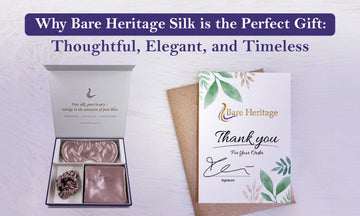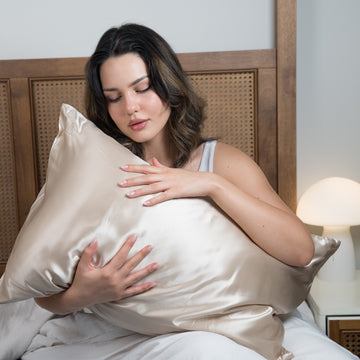Satin vs Silk: Why Silk Is the Better Choice and Worth Every Penny

When it comes to luxury fabrics, few materials feel as elegant and refined as silk and satin. Both offer a glossy look and a soft texture, and they’re used in products like pillowcases, sleepwear, dresses, and bedding. However, many people don’t know the real difference between silk and satin, and often use the terms interchangeably.
Though similar at a glance, satin vs silk is a comparison that goes much deeper than just looks. From how they’re made to how they feel against your skin, these two materials offer very different experiences. If you’ve ever wondered which is better — silk vs satin pillowcase, or silk or satin for your skin and hair — we’ve got you covered.
In this guide, we’ll explore the key distinctions, the pros and cons of each, and why silk remains the superior choice for wellness, comfort, beauty, and sustainability.
What Is Silk?
Silk is a natural protein fiber produced by silkworms — specifically, from the Bombyx mori moth. As the larvae spin their cocoons, they produce a continuous thread, which is harvested and carefully woven into luxurious fabric. This process takes time, effort, and skill, which is why silk is considered a premium fabric.
The outcome is a material that’s incredibly soft, smooth, breathable, and durable. Silk is hypoallergenic, temperature-regulating, and biodegradable. When you compare silk vs satin, silk’s natural origin is one of its biggest advantages.
What Is Satin?
Satin isn’t a type of fiber. It’s a weave pattern that creates a glossy surface and a dull back. Satin can be woven from silk, but most modern satin is made from polyester, nylon, or acetate — all of which are synthetic fibers.
Think of satin as a copycat of silk. It tries to mimic the shine and feel, but it lacks silk’s natural benefits. A key part of the difference between silk and satin is this: silk is natural, while satin is usually synthetic.
This matters when you consider satin vs silk pillowcase choices. While both may look similar, they perform very differently — especially over time.
-
Feel and Comfort
Let’s talk comfort. The most noticeable factor when choosing satin or silk pillowcase is how they feel on your skin.
Silk: It’s smooth, soft, and breathable. It feels cool in summer and warm in winter, thanks to its natural temperature-regulating properties. Silk is gentle on sensitive skin and doesn't cause irritation or friction.
Satin: It can feel smooth at first, but it’s not breathable. Satin tends to trap heat and can cause sweating. It may also become static-prone, especially if made from polyester.
Verdict: Silk offers unmatched softness and comfort. In the silk vs satin debate, silk wins for everyday comfort and luxury.
-
Breathability and Skin Benefits
One of the most important reasons people switch to silk pillowcases is for skin and hair health.
Silk: Silk helps retain your skin’s moisture, which is ideal for those with dry or sensitive skin. It also reduces friction on your hair, preventing breakage and frizz. It’s often recommended by dermatologists and hair stylists.
Satin: Synthetic satin can clog pores and trap sweat, especially during hot nights. It’s slippery, but not always gentle. People with acne-prone or sensitive skin might not benefit as much.
Verdict: For clear skin and smooth hair, silk clearly outperforms satin. That’s why many people search "is satin good for hair" and eventually find themselves switching to silk.
-
Durability and Longevity
Many people think silk is fragile, but it's actually stronger than it looks.
Silk: Silk is one of the strongest natural fibers. With proper care, a silk pillowcase or garment can last for years. At Bare Heritage, we use 100% pure 6A mulberry silk — the highest quality available. It’s designed to stay soft and shiny over time.
Satin: Satin is more likely to snag, pill, or lose its shine. After several washes, it may start to feel rough or lose its shape.
Verdict: Natural silk vs synthetic satin is no contest. Silk lasts longer, performs better, and holds its value.
-
Environmental Impact
Eco-conscious shoppers will want to compare the sustainability of silk vs satin.
Silk: It’s biodegradable, renewable, and sustainably farmed when produced responsibly. At Bare Heritage, we’re committed to OEKO-TEX® certified silk, which means it’s free from harmful chemicals.
Satin: Most satin is made from plastic-based materials. These don’t break down in the environment and contribute to microplastic pollution.
Verdict: If you're looking for a green choice, silk is the clear winner.
-
Cost and Value
There’s no denying that silk comes at a higher price. But is it worth it?
Silk: Yes, it costs more upfront. But when you consider its skin and hair benefits, its comfort, and its long lifespan, the value is clear. A silk pillowcase can outlast several satin ones.
Satin: It’s cheaper and more widely available. But low cost often means low performance. You may need to replace satin items frequently, making it more expensive in the long run.
Verdict: When weighing satin vs silk pillowcase, silk is the smarter long-term investment.
-
Style and Appearance
Want your bedding or wardrobe to feel luxurious? Then material matters.
Silk: It has a natural luster that never looks cheap. It drapes beautifully and absorbs dyes deeply, giving it a rich, vibrant color. Whether it’s a silk eye mask, blouse, or pillowcase, it always looks high-end.
Satin: Satin may shine, but it can look overly glossy or fake. It often loses its sheen quickly, especially when machine washed.
Verdict: For elegance and beauty that lasts, silk or satin isn't a hard choice — silk takes the crown.
-
Health and Wellness Benefits
More than just beauty sleep, silk helps promote wellness.
Silk: Its natural fibers are resistant to dust mites and mold. It’s ideal for people with allergies, asthma, or sensitive skin. That’s why so many experts recommend silk pillowcase benefits for better sleep and healthier skin.
Satin: It doesn’t offer the same protection. Synthetic satin may even cause irritation for some users.
Verdict: When it comes to self-care, silk supports better health, naturally.
Conclusion: Silk Is the Smarter, More Luxurious Investment
If you’re choosing between a satin or silk pillowcase, or just trying to understand the difference between silk and satin, this guide should make your decision easier.
Silk outshines satin in nearly every category — comfort, breathability, skin care, sustainability, durability, and appearance. At Bare Heritage, we offer 100% pure mulberry silk with a rich 22 momme weight, more than the industry average. All our silk garments are OEKO-TEX® certified. That means no harmful dyes or chemicals, just clean, high-quality silk.
Satin may be cheaper upfront, but you get what you pay for. Silk vs satin pillowcase isn’t just about price—it’s about long-term value. You’re investing in quality sleep, healthy skin, beautiful hair, and a fabric that lasts.
So, make the switch. Upgrade to silk. Experience the feeling of true luxury.
Bare Heritage Silk isn’t just a luxury — it’s a lifestyle.



